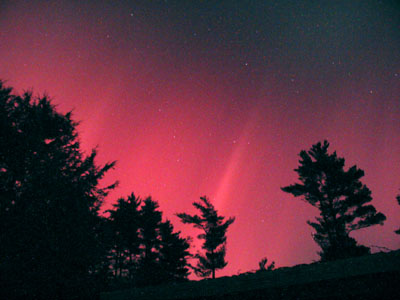
This evening between about 6:30pm and 8:00pm (EST) there was a spectacular display of the Aurora Borealis (Northern Lights)! I was tipped off to this by Scott Tracy's post on the ASGH newsgroup. I was also (coincidentally?) having a lot of trouble with modem connections. When I stepped out onto the back deck, I could see rays of light coming up from the northern sky and it was not even dark yet! The entire sky (at that time) seemed to have a haze over it as if a thin layer of clouds had come in. However these were not clouds! I set up a film camera as fast as I could and took a number of exposures lasting around 15 seconds each (400 speed film with a 28mm F2.8 lens). I ran out of film and then decided to try the digital camera. In the past I had found that the camera I have is not that great for night work (too much noise in the CCD). However, in an effort to conserve battery power, I turned off the LCD screen (located at the back of the camera not far from the CCD chip inside). This turned out to help a lot: the resulting images, while still containing some noise, were a lot better than some I had taken on previous occasions using the camera.
The aurora was an amazing sight: at times the entire sky was glowing, including the deep south! At one point there were 4 or 5 pillars rising from the north, nearly meeting overhead. Also there were some interesting "patches" of glow isolated from others, high up in the sky. The sky had the appearance of having bad light pollution all around. After 7pm it should have been astronomically dark, but the sky was not at all dark. Faint stars were washed out in the glow. Pillars continued to come and go, lasting 10 to 20 seconds (at their brightest). Also, large areas of the sky near the horizon were observed to be glowing with no particular form.
The photos directly below (digital camera photos) were taken using an Olympus C3030Z camera. These were taken after the peak of the show had passed (I took film pictures during that time). I set the camera to manual mode, the lens was at F2.8, ISO was set to 400 (although I do not believe this really makes the CCD "faster"), the flash was forced OFF, the focus was set to infinity, the shutter release was set to use the remote control, and the exposure time was set to 10 seconds (this camera can do a maximum of 16 second exposure). The camera was tripod mounted and exposures were triggered using the remote (to eliminate vibrations). The photos that resulted did have some noise. By shrinking the photos in Photoshop and using some amount of "dust and scratch" removal, the photos were made to look reasonably decent.

Northern Lights #1. 10 Second exposure. View taken from my back deck looking to northeast, the constellation Perseus can be faintly seen rising.
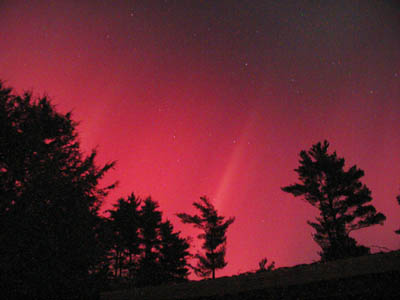
Northern Lights #2. Same basic view as above.
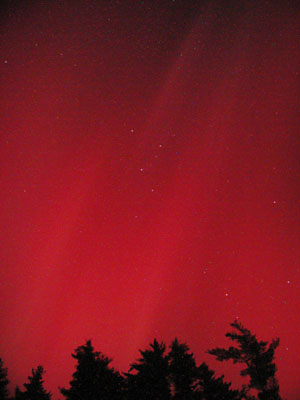
Northern Lights #3. 10 second exposure. Note the deep red tint of the sky. The constellation Cassiopeia can be seen at the middle of this photo.
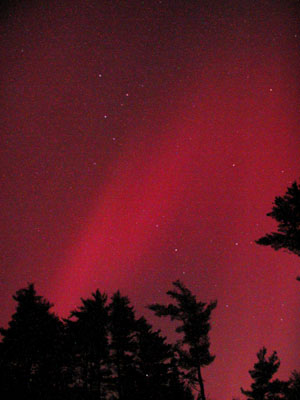
Northern Lights #4. 10 second exposure. A large, broad pillar is seen here. The constellation Cassiopeia can be seen at the middle of this photo.
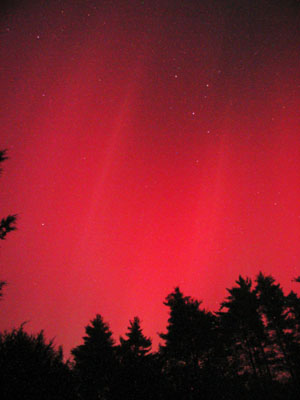
Northern Lights #5. 10 second exposure. Another shot of pillars near Cassiopeia.
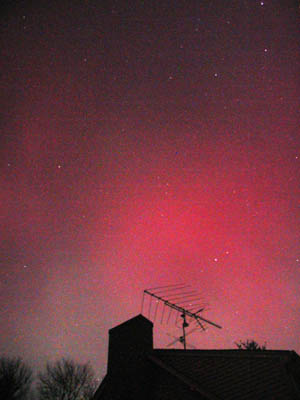
Northern Lights #6. 10 second exposure. Looking to the southwest over my house. The bright star above and to the right of the antenna is Altair..
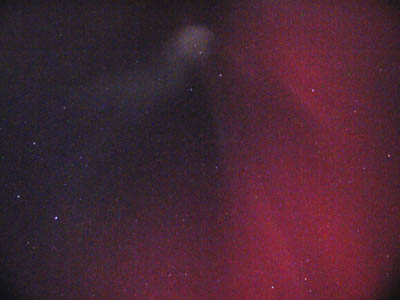
Northern Lights #7. 10 second exposure. A very interesting display that was nearly overhead. The bright star to the lower left is Deneb (south in this photo is to the left.
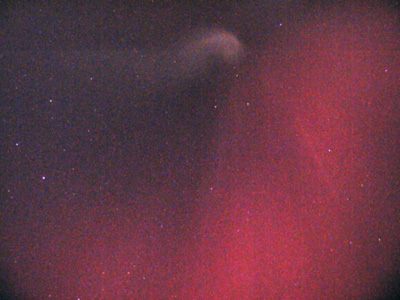
Northern Lights #8. 10 second exposure. A shot of the same area as above taken a short time later. Some lens vignetting is evident at the corner of this photo.
Below are samples of the best film pictures I obtained. The images below are scans of the negatives. The film, being 400 speed (the only thing I had on hand and a bit out of date at that) is a bit grainy. Overall I am quite pleased to have ben able to see and photograph this event!
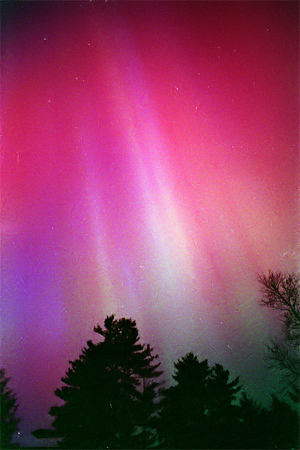
Northern Lights, film frame #2. ~15 second exposure. Film was Kodak MAX 400, lens was 28mm F2.8. Tripod mounted exposure looking a little left of north from my backyard in Voluntown CT.

Northern Lights, film frame #3. ~15 second exposure. Film was Kodak MAX 400, lens was 28mm F2.8. Tripod mounted exposure looking to the northwest from my backyard in Voluntown CT. Lyra and Cygnus can be seen (faintly) behind the glow. Vega is just about at the center of the image while Deneb is near the top. Both of these stars are very prominent in a dark sky, but in this aurora they are not nearly as easily seen!
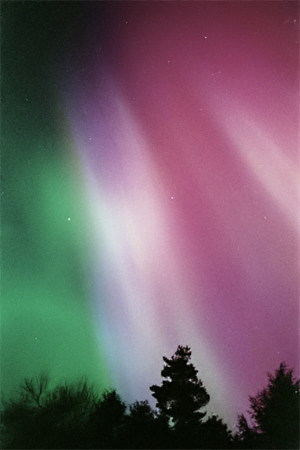
Northern Lights, film frame #4. ~15 second exposure. Film was Kodak MAX 400, lens was 28mm F2.8. Tripod mounted exposure looking to the northwest from my backyard in Voluntown CT. "Lost" in the aurora are Lyra and Cygnus. Vega is the star a little right of center.
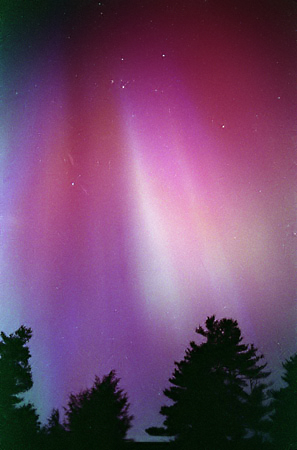
Northern Lights, film frame #5. ~15 second exposure. Film was Kodak MAX 400, lens was 28mm F2.8. Tripod mounted exposure looking to the northwest from my backyard in Voluntown CT.
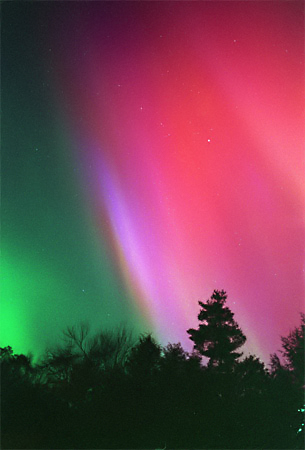
Northern Lights, film frame #6. ~15 second exposure. Film was Kodak MAX 400, lens was 28mm F2.8. Tripod mounted exposure looking to the northwest from my backyard in Voluntown CT. The "bright" star a little above and to the right of center is Vega. This star vgives some relative idea of how bright this aurora was!
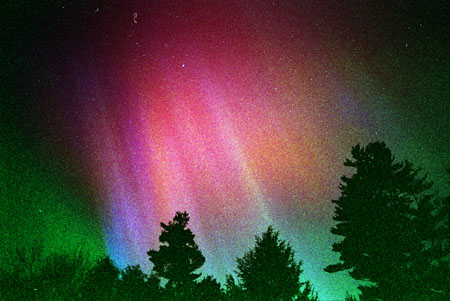
Northern Lights, film frame #8. ~15 second exposure. Film was Kodak MAX 400, lens was 28mm F2.8. Tripod mounted exposure looking to the northwest from my backyard in Voluntown CT. Vega is seen a little above left center in this photo. Aurora was fading a bit as this photo was being taken.
Use your browser's "back" button, or use links below if you arrived here via some other path:
This page is part of the site Amateur Astronomer's Notebook.
E-mail to Joe
Roberts
Images and HTML text © Copyright 2003 by Joe Roberts. Please request permission to use photos for purposes other than "personal use".